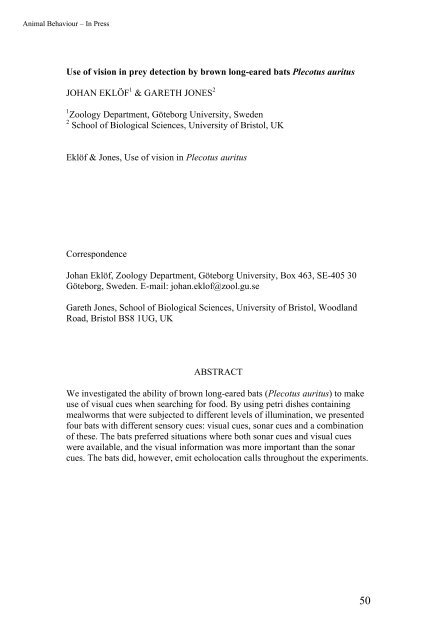Vision in echolocating bats - Fladdermus.net
Vision in echolocating bats - Fladdermus.net
Vision in echolocating bats - Fladdermus.net
You also want an ePaper? Increase the reach of your titles
YUMPU automatically turns print PDFs into web optimized ePapers that Google loves.
Animal Behaviour – In Press<br />
Use of vision <strong>in</strong> prey detection by brown long-eared <strong>bats</strong> Plecotus auritus<br />
JOHAN EKLÖF 1 & GARETH JONES 2<br />
1 Zoology Department, Göteborg University, Sweden<br />
2 School of Biological Sciences, University of Bristol, UK<br />
Eklöf & Jones, Use of vision <strong>in</strong> Plecotus auritus<br />
Correspondence<br />
Johan Eklöf, Zoology Department, Göteborg University, Box 463, SE-405 30<br />
Göteborg, Sweden. E-mail: johan.eklof@zool.gu.se<br />
Gareth Jones, School of Biological Sciences, University of Bristol, Woodland<br />
Road, Bristol BS8 1UG, UK<br />
ABSTRACT<br />
We <strong>in</strong>vestigated the ability of brown long-eared <strong>bats</strong> (Plecotus auritus) to make<br />
use of visual cues when search<strong>in</strong>g for food. By us<strong>in</strong>g petri dishes conta<strong>in</strong><strong>in</strong>g<br />
mealworms that were subjected to different levels of illum<strong>in</strong>ation, we presented<br />
four <strong>bats</strong> with different sensory cues: visual cues, sonar cues and a comb<strong>in</strong>ation<br />
of these. The <strong>bats</strong> preferred situations where both sonar cues and visual cues<br />
were available, and the visual <strong>in</strong>formation was more important than the sonar<br />
cues. The <strong>bats</strong> did, however, emit echolocation calls throughout the experiments.<br />
50


